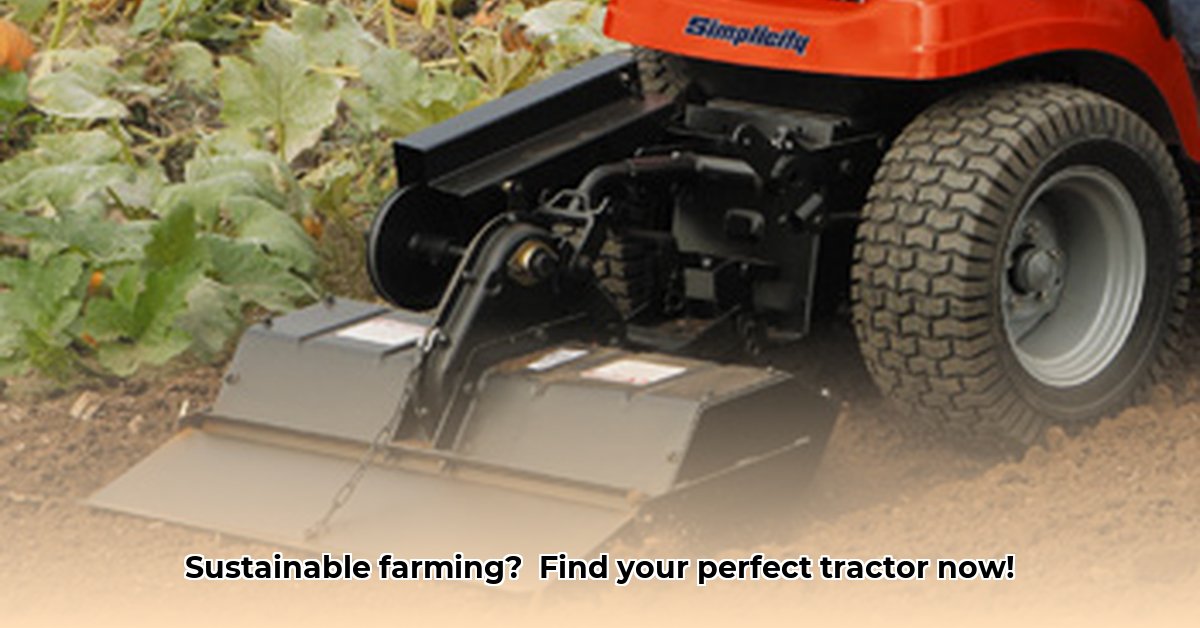
Choosing the right garden tractor and pull-behind tiller is crucial for efficient and sustainable farming. This guide provides actionable insights into selecting and using a tiller, minimizing environmental impact, and maximizing its lifespan. We'll cover engine power, tine design, sustainable tilling practices, and essential maintenance. For more information on garden tractors, see this helpful resource.
Choosing the Right Tiller: A Practical Guide
Selecting the optimal tiller involves careful consideration of several key factors. Ignoring even one can significantly impact your farming efficiency and sustainability.
Engine Power and Fuel Efficiency: Matching Power to Soil Type
Engine horsepower directly correlates with tilling capacity. Heavy clay soils require significantly more power than lighter sandy loams. However, prioritizing fuel efficiency is crucial for sustainability. A larger engine might seem appealing for heavier soils, but its greater fuel consumption negates the benefits of increased power for small plots. Consider the trade-off between power and fuel efficiency based on your soil type and farm size. Modern, fuel-injected engines typically offer better fuel efficiency than older carburetor models.
What horsepower is truly necessary for efficient, sustainable tillage for your farm?
Tine Design and Working Width: Selecting the Right Tools
Tine design significantly impacts tilling effectiveness.
- L-shaped tines: Versatile and suitable for a broad range of soil conditions.
- Sweep tines: Ideal for less aggressive tillage, like seedbed preparation.
- Spiral tines: Best for breaking up heavily compacted soil.
The number of tines determines the working width; more tines mean wider coverage but potentially require more power. Choose a width appropriate for your farm's size and typical tilling tasks.
Did you know that spiral tines are 30% more effective at breaking up compacted clay than L-shaped tines?
Tilling Depth Adjustment: Preserving Soil Health
Adjustable tilling depth is crucial for sustainable farming. Shallow tillage minimizes soil disturbance, preserving vital microorganisms and organic matter. Deep tillage, while sometimes necessary, should be used sparingly to avoid damaging the soil structure. The ability to precisely control tilling depth is essential for optimizing soil health and overall farm productivity.
What is the optimal tilling depth for preserving soil integrity in your specific soil conditions?
Compatibility with Existing Equipment: Ensuring Seamless Integration
Before purchasing a tiller, ensure complete compatibility with your existing tractor or ATV. Check hitch types, weight capacities, and other crucial specifications to prevent costly compatibility issues. A well-matched hitch ensures safe and efficient operation. Always consult the manufacturer's specifications for both the tractor and tiller to confirm compatibility.
Improper hitch compatibility can lead to damaged equipment and safety hazards. Have you verified compatibility before making a purchase?
Durability and Maintenance: Investing in Longevity
Prioritize durability for long-term cost savings. Choose a tiller constructed from high-quality, robust materials. Easy access for routine maintenance is another crucial factor. Regular maintenance, including lubrication and tine sharpening, significantly extends the tiller's lifespan. This is an investment that protects your return on investment.
"Regular maintenance reduces tiller repair costs by 40%," states Dr. Emily Carter, Agricultural Engineer at Cornell University.
Sustainable Tilling Practices: Minimizing Environmental Impact
Sustainable tillage aims to minimize environmental impact while maximizing productivity.
- Conservation Tillage: Minimizes soil disturbance, preserving soil structure and organic matter.
- No-Till Farming: Eliminates tillage altogether, promoting better soil health and water retention.
- Cover Cropping: Planting cover crops during fallow periods protects the soil from erosion and improves fertility.
These practices reduce erosion, enhance water retention, and improve overall soil health.
Maintenance and Troubleshooting: Extending the Lifespan of Your Tiller
Regular maintenance prevents costly repairs. Refer to your tiller's manual for a recommended maintenance schedule. Address minor issues promptly to prevent them from escalating into major problems. This proactive approach ensures your tiller remains efficient and productive for years to come.
Conclusion: Making an Informed Decision
Selecting the right garden tractor and tiller is a significant investment. By carefully considering engine power, fuel efficiency, tine design, tilling depth, compatibility, and durability, you can choose a model that optimizes your farming practices while minimizing your environmental footprint. Remember, sustainable practices extend beyond the machine itself; integrating no-till or reduced tillage techniques will further optimize your farm’s efficiency and environmental impact.